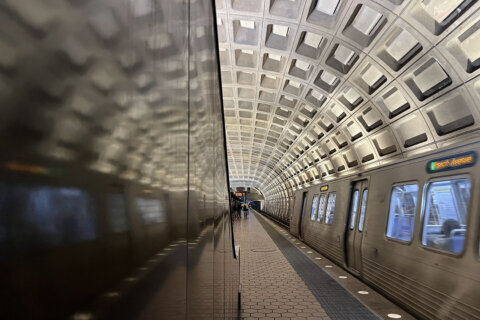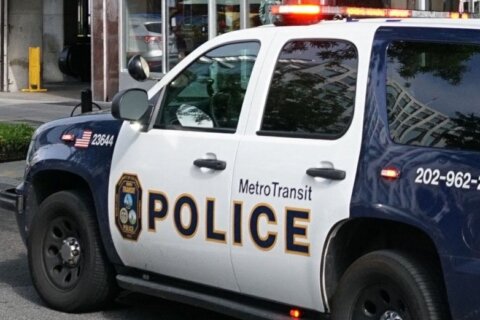WASHINGTON — New taxes to help fund Metro and major changes to how the transit agency operates would be in store if the region signs onto General Manager Paul Wiedefeld’s plan to address the system’s funding.
In the past, the agency’s funding issues have contributed to subway breakdowns, delays and jurisdictional squabbling. Here’s what riders and area taxpayers need to know about Wiedefeld’s goals for the plan, reaction and what happens next.
The plan in brief
Wiedefeld’s plan to save Metro and stabilize its finances largely breaks down into three pieces:
1 — Congressional action to maintain or expand federal funding for capital costs, including renewal of the $150 million per year contribution set to expire next year. Congressional action would also be needed to change arbitration rules to favor Metro over its employees.
2 — Virginia, Maryland and D.C. — both state and local — governments must approve of a yet-to-be-determined, dedicated capital funding source totaling $500 million per year. The new money would come in exchange with a promise from Metro that existing state and local contributions to the transit system would rise by no more than 3 percent each year. Metro would also establish a rainy-day fund as part of its operating budget.
3 — A series of operating changes Metro can mostly implement on its own including contracting out work for operations like parking to private companies. Metro would also attempt to further shrink the number of workers at the agency by taking steps like automating track inspections, and by making it easier to reduce rail and bus service.
Wiedefeld’s plan assumes that fares would increase every two years, as current Metro Board policy calls for. Fares are set to go up this summer for the first time in three years, including significant jumps for non-rush hour rail rides. Bus riders will also pay more.
Regional reaction
Rep. Barbara Comstock, the sole Republican on Capitol Hill who represents an area served by Metro, said in a statement that she needs more details and justifications for the plan before taking a position on it. She is scheduled to meet with Wiedefeld next week — part of his push to lay out his plan to elected leaders and business groups in the region.
Wiedefeld has separately scheduled town hall sessions with Metro workers in an effort to bring them on board.
“All of our employees need to understand the conditions we’re under,” he said.
Metro’s largest union, Amalgamated Transit Union Local 689, responded that the plan is “bad for riders, bad for workers and bad for the region.”
“His solution is to outsource services more and more of the system, which will make the system less safe, less reliable, more costly and demoralize the workforce in a race to the bottom,” the union said in a statement.
According to the union, the plan pits riders against workers.
Wiedefeld said he reached out to the union before releasing his plan to the public Wednesday evening.
“It’s just the financial realities we’re under, and so I’ve got to explain that better to them. They have to understand that. They may not agree with it, but that isn’t because I’m trying to do anything against them personally,” Wiedefeld said.
The union released its own proposals last month.
Montgomery County Council President Roger Berliner endorsed the dedicated funding suggestion in Wiedefeld’s proposal, and said he would work with others in the region to figure out how to raise the money.
D.C. Council member and Metro Board Chair Jack Evans endorsed the entire plan.
What would it change?
If the funding comes through, Wiedefeld promises smoother, more consistent rides after more repairs and long-term maintenance is completed in the next decade.
“Safety will be almost a nonissue in people’s head … When you get on an elevator, you never think about safety generally, you usually get on an elevator and it goes up. Right? It goes down. That’s what it does. And when you think about our system, particularly the rail system, it’s a horizontal elevator. You should just get on the thing and that should never be an issue for you,” he told reporters Thursday morning.
“It comes, and you go. And you don’t sit there for 20 minutes … Occasionally things will happen for us in the future, these are complex systems,” he said. But those unplanned mechanical problems would occur less frequently.
His plan calls for $15.5 billion in work out of the total $25 billion worth of repairs and improvements that Metro officials believe the system requires.
“We’re not suggesting that we attack all that right now for a number of reasons. One is, physically could we deliver that much, and then just what that would mean in terms of the impact on customers. Because to do that type of spending, you’d have to use that much more time out on the tracks,” Wiedefeld said.
Such major maintenance projects would require trains to share a single track or shutdowns outside of the rush hour.
“Just like on a highway, those are built in delays that you know are going to happen. But what I’m trying to get at is the delays that we don’t know are going to happen,” Wiedefeld said.
He hopes that if the system becomes more reliable, riders will return, which would also help Metro’s financial picture.
Service cuts
Operational changes suggested in Wiedefeld’s plan include the authority to reduce bus and rail service in response to declining ridership.
A number of bus routes could be cut that were saved from the chopping block this year because of the crucial connection they provide to some communities. In addition, the new policy might allow rail schedule adjustments too.
Wiedefeld said key questions would be whether the service provides the best value, given the money available, and the impact to riders and communities.
“We have to start to change the cycle on the operating costs, and particularly on some of the labor-related costs,” Wiedefeld said.
Metro and ATU Local 689 remain in contract talks to extend the deal that expired at the end of June.
Under Wiedefeld’s proposal to change arbitration rules, contracts talks or other issues dealing with worker disputes could be more frequently decided in favor of the transit agency.
If his proposal became law, arbitrators would have to look beyond the agreements and history to also factor in Metro’s and the region’s willingness to pay.
Automation, privatization and big changes for the future
The plan also calls for cutting staff at Metro by automating some jobs and contracting out other jobs to private companies.
For example, Metro is examining how to automate track inspections like London’s Underground has done, Wiedefeld said. That would potentially require fewer inspectors.
Contracting out parking garages or maintenance shops could lower Metro’s costs because contractors would not necessarily have to pay workers as much.
“We also have to look at other sources of revenues, besides just our riders: advertising, joint development, other things, we should be looking at the parking arrangement that we do for instance. If you look at other systems around the globe, particularly in Asia, they have much more of a concession model similar to an airport model, for instance, where they generate dollars through other means, besides just the people that are catching the planes,” Wiedefeld said.
He suggested more programs like the pilot project at Grosvenor-Strathmore where small retail shops are scheduled to open outside the station.
“I’ve had experience in the aviation world. You look at BWI (Marshall) Airport, and you know that’s a state owned facility, it’s supported by the exact same funding source that this agency’s supported by. The parking revenue up there — I was making 89 cents on the dollar — and that was all done by contractors,” he said.
Wiedefeld spent almost a decade running BWI Airport.
Will any of this actually happen?
Now that the plan is out, Wiedefeld plans to hit the road to explain it. He is hopeful that the plan will garner support because so many people across the region believe Metro, the backbone of the area’s transportation network, cannot be allowed to fail.
“We’ve tried as a team to craft this to try to pull in as many of the issues as we can … and the concerns of everyone involved,” he said.
Similar reports, white papers and plans have been released many times during the 41 years of Metro’s existence with little change in the end.
“I’m hoping, I’m very positive … about it,” Wiedefeld said of this effort.
He hopes to work with business groups like the Greater Washington Board of Trade and the Federal City Council that have already put out their own proposals, plus other local leaders. He has already met with members of the group working with former U.S. Transportation Secretary they may offer this fall.
“Hopefully we put out enough there that people can start to say OK, this is something that we can at least get our arms around to start to have these hard discussions and make some decisions,” Wiedefeld said.
Ideally, a blueprint would be in place by September when Metro begins to work on its budget for the following year, Wiedefeld said.
But there is little agreement so far on how to move forward.
“They all want to try to do something to get this right, so that’s a good place to start,” Wiedefeld said.
Without any changes, Wiedefeld said Metro will decline more quickly.
“The slide we’ve been on, that would get steeper and steeper, and worse for our customers,” he said.






